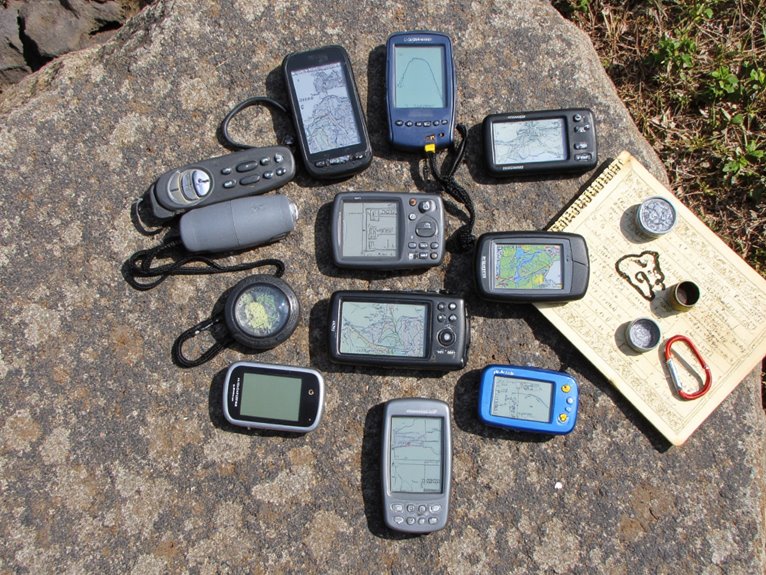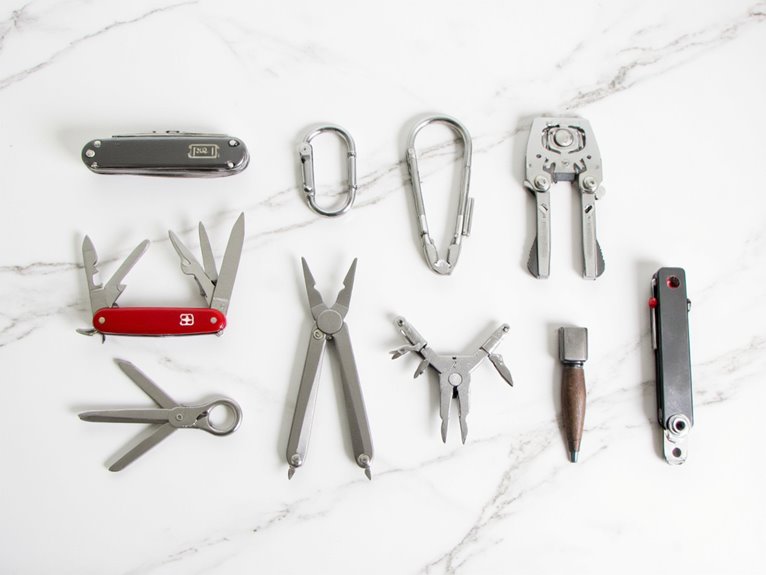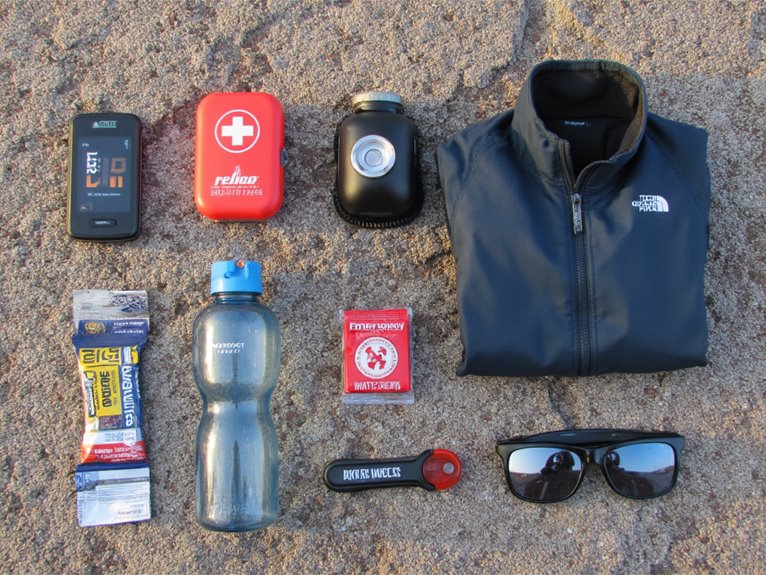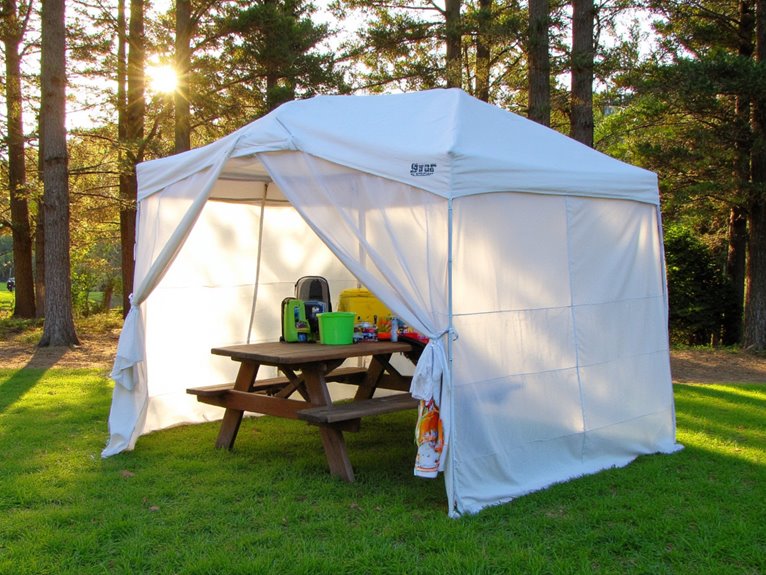Breathing Techniques for Climbing at Altitude
You’ll need to master diaphragmatic breathing and pursed-lip techniques to maximize oxygen intake at high altitudes where atmospheric pressure drops 25%. Start with inspiratory muscle training using resistance devices, then practice pressure breathing that combines belly breathing with forced exhalation to counter pressure drops. Implement breath-holding drills and voluntary isocapnic hypoventilation training to condition your body for low-oxygen environments. These techniques strengthen respiratory muscles and improve oxygen utilization efficiency. Advanced protocols await your exploration.
We are supported by our audience. When you purchase through links on our site, we may earn an affiliate commission, at no extra cost for you. Learn more. Last update on 8th January 2026 / Images from Amazon Product Advertising API.
Notable Insights
- Practice diaphragmatic breathing to maximize oxygen intake and lung expansion in low-oxygen environments.
- Use pursed-lip breathing to maintain consistent airway pressure and control breathing during physical exertion.
- Train with inspiratory muscle strengthening devices to build respiratory endurance before your expedition.
- Implement pressure breath technique combining belly breathing with forced exhalation to counter altitude pressure drops.
- Perform breath-holding drills and voluntary isocapnic hypoventilation training to condition your body for hypoxic conditions.
Understanding How Altitude Affects Your Breathing and Performance
When you ascend to higher elevations, your body immediately encounters a fundamental challenge that directly impacts your climbing performance: decreased atmospheric pressure.
This pressure drop creates a linear reduction in available oxygen, causing your arterial oxygen partial pressure (PaO2) to fall considerably. Your body responds with immediate hyperventilation as peripheral chemoreceptors detect the oxygen deficit.
Your heart rate accelerates through sympathetic nervous system activation, working harder to deliver oxygen to working muscles. This altitude adaptation process triggers increased red blood cell production within days, enhancing your blood’s oxygen transport capacity.
Meanwhile, your kidneys excrete bicarbonate to counteract respiratory alkalosis from hyperventilation, causing frequent urination.
These physiological changes represent your body’s systematic response to hypoxic stress, fundamentally altering your breathing patterns and cardiovascular function during climbing activities.
Essential Breathing Techniques Every High-Altitude Climber Should Master
Five fundamental breathing techniques form the cornerstone of successful high-altitude climbing performance, each targeting specific physiological challenges you’ll encounter above 8,000 feet.
Diaphragmatic breathing maximizes oxygen intake by engaging your primary respiratory muscle. The diaphragmatic benefits include enhanced lung expansion and reduced stress responses in oxygen-thin environments.
Proper diaphragmatic breathing engages your primary respiratory muscle, delivering maximum oxygen intake while reducing stress in thin-air conditions.
Pursed-lip breathing controls exhalation rate through partially closed lips, maintaining consistent airway pressure during physical exertion. Pursed lip applications prove essential when managing altitude sickness symptoms or steep ascents.
Breath-holding drills condition your body for low-oxygen conditions by improving efficiency.
The pressure breath combines belly breathing with forced exhalation to counteract atmospheric pressure drops.
Voluntary Isocapnic Hypoventilation Training maintains CO2 levels while reducing breathing frequency, accelerating altitude adaptation and improving overall respiratory coordination during challenging climbs.
Building Respiratory Muscle Strength Through Targeted Training
Mastering breathing techniques alone won’t prepare your respiratory muscles for the sustained physical demands of high-altitude climbing.
You need targeted Respiratory Muscle Strength Training (RMST) to develop the diaphragm and intercostal muscles that power efficient oxygen uptake in thin air.
RMST builds respiratory capacity through systematic conditioning:
- Inspiratory Muscle Training – Use resistance devices like PowerBreathe units that create pressure threshold loading, forcing your diaphragm to work harder during inhalation.
- Expiratory Muscle Training – Strengthen abdominal muscles through controlled resistance breathing exercises.
- Endurance Training – Practice voluntary isocapnic hyperventilation techniques to build stamina.
- Progressive Resistance – Follow the 5/5/5 protocol: five breaths, five sets, five sessions weekly.
This systematic approach reduces dyspnea and enhances your climbing performance at altitude.
Creating an Effective Pre-Expedition Breathwork Training Program
Before you can tackle demanding high-altitude expeditions, you’ll need a systematic breathwork training program that builds both physiological capacity and mental resilience over a structured timeline.
Start with extensive breath assessment protocols. Conduct your Body Oxygen Level Test and Carbon Dioxide Tolerance Test to establish baseline metrics. These measurements guide your training variability throughout the five-week program.
Establish your respiratory baseline through comprehensive oxygen and carbon dioxide testing before beginning any structured altitude training program.
Week one focuses on baseline testing and controlled simulation exercises.
Weeks two and three emphasize sport-specific protocols and respiratory muscle strengthening.
Week four integrates high-intensity breathwork with mental fitness training.
Final week consolidates techniques for expedition application.
Progressive altitude simulation exercises prepare your system for hypoxic conditions.
Combine “Breathe Light” techniques with exhale pulsations to enhance oxygen efficiency.
Monitor your progress through periodic reassessments, adjusting intensity based on your physiological responses and subjective exertion levels.
Mental Benefits and Acclimatization Strategies for Optimal Performance
While physical conditioning prepares your body for altitude, your brain undergoes equally critical adaptations that directly impact climbing performance and safety.
Mental resilience develops through neuroadaptation mechanisms that enhance oxygen efficiency and cognitive stability. Your brain increases cerebral blood flow by 20-30% during initial altitude exposure, compensating for reduced oxygen availability.
Effective cognitive adaptation requires systematic strategies:
- Gradual ascent pacing – limits neurological stress and preserves decision-making capacity
- Structured rest days – supports brain plasticity and neural reorganization processes
- Mental rehearsal techniques – strengthens psychological readiness for high-altitude challenges
- Breathing exercises – improves oxygen utilization and reduces hypoxia-induced cognitive deficits
Long-term altitude residents demonstrate superior task performance and attention span compared to newcomers, proving that proper acclimatization restores cognitive function to near sea-level standards.
Frequently Asked Questions
Can Breathing Techniques Help Prevent Acute Mountain Sickness Symptoms Completely?
No, you can’t completely prevent acute mountain sickness symptoms through breathing techniques alone. Controlled breathing patterns improve your blood oxygen saturation considerably-from 80% to 89% at extreme elevations-but they don’t eliminate underlying hypoxia-induced stress.
Your altitude adaptation requires gradual acclimatization and possibly medication like acetazolamide. Breathing exercises optimize oxygen uptake and reduce some symptoms, yet they can’t prevent serious complications like pulmonary edema.
How Do Breathing Exercises Differ for Children Versus Adults at Altitude?
You’ll find breathing exercises differ markedly between age groups due to children’s physiology versus adult adaptations.
Children can’t perform complex breathing techniques reliably and need simplified, supervised approaches.
Their lower oxygen saturation (94.1% vs 95.7%) and immature hypoxia adaptation require gentler strategies.
Adults can execute controlled breathwork like pursed-lip breathing effectively.
You must monitor children closely since they can’t communicate respiratory distress symptoms adequately at altitude.
Are There Any Medical Conditions That Contraindicate High-Altitude Breathing Techniques?
You shouldn’t use high-altitude breathing techniques if you have certain medical conditions.
Recent strokes, brain tumors, or diabetic neuropathy are absolute contraindications.
High altitude asthma and pulmonary hypertension greatly increase your risk of complications due to reduced oxygen availability.
COPD patients can’t safely ascend above 3000 meters.
Neuromuscular disorders reducing lung capacity by 60% also contraindicate these techniques.
What Emergency Breathing Methods Work Best During Sudden Altitude Sickness Episodes?
During sudden altitude sickness episodes, you’ll need immediate rescue breathing techniques.
Stop ascending immediately and perform deep diaphragmatic breathing at 6-8 breaths per minute.
Use pursed-lip breathing to maintain airway pressure and stabilize oxygen levels.
If available, administer supplemental oxygen at 2-4 liters per minute through a face mask.
These methods support altitude adaptation by maximizing oxygen uptake during acute hypoxic episodes.
How Long Do Breathing Technique Benefits Last After Returning to Sea Level?
Your recovery duration from altitude breathing adaptations occurs rapidly after descent.
Within days, your hyperventilation response normalizes as blood oxygen levels stabilize.
Sleep-related breathing improvements disappear within one week.
While respiratory muscle conditioning from deliberate breathing techniques provides short-term benefits, your altitude adaptation changes fade without continued hypoxic stimulus.
Individual variation exists, but most ventilatory adaptations regress quickly upon returning to sea level.
On a final note
You’ve learned the critical breathing techniques that’ll keep you performing at altitude. Master diaphragmatic breathing, box breathing, and pressure breathing before your expedition. Build your respiratory muscles with targeted training programs. Start practicing these methods at sea level, then gradually increase intensity. Your body needs time to adapt, so don’t rush the process. Consistent breathwork training isn’t optional-it’s essential for summit success and safety at elevation.




